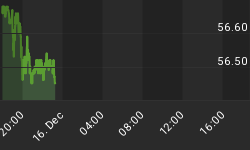It seemed like last month I was focusing on the bigger picture a lot more than I have been recently. This is a function of the calendar, in that all of the important data tends to be clustered towards the end of the month, but also of the opportunity. When economists and investors are on-the-ball, they shouldn't be blindsided by something as obvious as the fact that the sharp change in tax rates and withholding schedules at the end of the year, and the intentional direction of economic activity into Q4 in preference to Q1, was bound to cause an apparent acceleration in late Q4, and a deceleration in Q1. The fact that many economists and investors seemed to be taking the end-of-year data at face value indicated a potential opportunity.
January Consumer Confidence is a case-in-point. It was expected to decline slightly, to 65.1, and instead dropped to 58.6 - quite a sharp drop from the prior month (see chart, source Bloomberg), especially since December's figure was revised upward slightly. The overall level of Consumer Confidence sits at a lower level than any in 2012. Not to belabor the point, but this is entirely to be expected. However, as the upcoming data displays a zag to the data's December zig, expect the market mood to change. It has not yet changed, to be sure. The stock market put in yet another new high, and bonds another low, so the market mood remains bulletproof for now.

In addition to the headline Confidence number, I always look at the "Jobs Hard to Get" subcomponent, which rose to 37.7 from 36.1. That represents the sharpest rise (higher indicates that more respondents are calling jobs "hard to get," and so is a sign of economic languor rather than vigor) since the first half of last year. The level of this index tends to correlate reasonably well with the Unemployment Rate, and employment conditions generally. This leads me to suspect that tomorrow's ADP report (Consensus: 165k from 215k in Dec) is likely to be softer than expectations. It bears observing, however, that even the 37.7 "Jobs Hard to Get" number is lower (that is, stronger) than it was for all of 2012 up until November. Accordingly, I'd expect a rise in Friday's Unemployment Rate, but I wouldn't be shocked if we didn't see one.
The other important piece of data was the S&P Case-Shiller Home Price Index, released for November. The index rose 5.52% y/y ended in November, the highest rate of increase since 2006 (see chart, source Bloomberg).

Now, this isn't surprising because we've already had lots of other home price data for November and December, such as the Existing Home Sales and New Home Sales median price indices. But here is why you should care. Some observers have taken to dismissing the striking rise in these indices that we have so far seen; some have suggested that the home sales numbers are showing rising prices because the composition of the homes that are being sold is changing because of the paucity of credit available to lower-income (smaller home) borrowers. While using median prices, rather than mean prices, will tend to lessen this problem somewhat, it is a plausible hypothesis.
But the S&PCSSHPI[1] is designed to be a constant-quality index, and the index is calculated on the basis of repeat sales of the same homes. Thus, it doesn't suffer from the composition-of-sales bias that the Existing and New Home Sales data might have - and it also shows that home price increases are accelerating. Home prices, in short, really are rising at a faster pace than at any time since 2006, and at 3.6% above core inflation (3.8% if you also exclude shelter from core inflation). As we've been saying for months, there is very little risk that core inflation is going to fall appreciably any time soon, when 40% of it (housing) is seeing an accelerating rate of inflation.
On Wednesday, in addition to the aforementioned ADP, we'll get the advance release of Q4 GDP (Consensus: 1.1%, 2.1% Personal Consumption). I suspect that this is likely to be exceeded, although doing the GDP math for the advance report (which involves a fair number of estimates) is a bit beyond my art. If it really comes in as weak as 1.1%, then this coupled with a weak ADP could give the bond bulls some cover. If instead the GDP figure is a surprise on the high side, then given the current state of market emotion I'd expect investors to latch onto the (old news) Q4 GDP data and ignore the news from January.
But the key event of the day is the announcement of the FOMC's decision around 2:15ET. There is not likely to be much of note to come from the FOMC statement, which ought to be largely unchanged. With all of the uncertainty surrounding the year-end data and the fiscal cliff/debt ceiling debates still ahead, the Committee will not be rocking the boat in January.
[1] I just felt like abbreviating since the Standard & Poors/Case-Shiller Home Price Index is ridiculously long, and I was curious whether the abbreviation helped. It doesn't, unless you're tweeting.
















